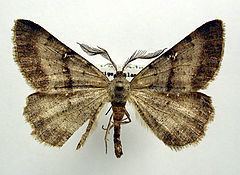Family Geometridae Rank Species | Genus Selidosema Order Butterflies and moths | |
 | ||
Similar Butterflies and moths, Cleora cinctaria, Aethalura punctulata, Peribatodes secundaria, Paradarisa consonaria | ||
Description
The Bordered Grey (Selidosema brunnearia) is a moth of the Geometridae family. It is found in Central and Southern Europe, Asia Minor, Transcaucasia and North Africa. The wingspan is 37–43 mm.Brown or purple-brown with dark discal dots or spots, the lines and distal band usually indicated on the forewing, but very variably, the lines wanting on the hindwing. Female much smaller-winged than male, with stout abdomen, moderately well marked. - pyrenaearia Bsd. has a very strongly expressed dark median line but the dark marginal band obsolescent. Pyrenees and Spain. - pallidaria Stgr. is a very weakly marked, cinereous whitish form from Sicily, Dalmatia, etc.- syriacaria Stgr.shows a similar pale ground-colour but the discal spots, median line of forewing and submarginal bands are well developed. Syria. - scandinaviaria Stgr. is dark violet-grey, the median line present, the distal bands broad. Scandinavia. -oelandica Wahlgren is a modification of the preceding, perhaps less dark grey, with an additional dark band occupying the entire space between median and postmedian lines, which are both black. Oeland. Perhaps not separable from the following. - oliveirata Mab. Similar to scandinaviaria but with a broad fuscous median band on the forewing. Portugal. - granataria Ebr. seems to be also an aberration of plumaria, with the median shade of the forewing composed of 3 spots, the pale subterminal line (band) unusually distinct. Andalusia.
Contents
Biology
There is one generation per year with adults on wing from July to August. The habitat consists of heath, dunes and calcareous grassland. The larvae feed on Calluna vulgaris, Cytisus scoparius, Rumex and Lotus species. The larvae can be found from September to July. It overwinters in the larval stage.
Subspecies
The following subspecies are known:
